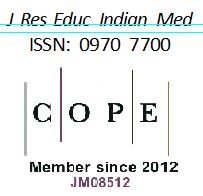
1. JREIM Covering Letter and Authors Declaration Form (Section 1-5) Ver. Jan 2021
2. TITLE page - Abstract - References etc-Sections -1 to 6 (NEW 2020-21)
3.JREIM Proforma for Authors CV and Declaration cum Consent Form-Ver-R -151022
4. JREIM Template for Submitting Manuscript in JREIM
| Case Report Online Published: 07 Oct 2018 | ||||||||||||||||||||||||||||||
MANAGEMENT OF A RARE CASE OF PYODERMA GANGRENOSUM THROUGH AYURVEDA A CASE STUDY Vaishali Vasantrao Kuchewar.
| ||||||||||||||||||||||||||||||
| How to Cite this Article |
| Pubmed Style Vaishali Vasantrao Kuchewar. MANAGEMENT OF A RARE CASE OF PYODERMA GANGRENOSUM THROUGH AYURVEDA A CASE STUDY. J Res Educ Indian Med . Online First: 07 Oct, 2018. doi:10.5455/JREIM.82-1521616376 Web Style Vaishali Vasantrao Kuchewar. MANAGEMENT OF A RARE CASE OF PYODERMA GANGRENOSUM THROUGH AYURVEDA A CASE STUDY. https://www.jreim-ayushjournal.com/?mno=294430 [Access: September 12, 2024]. doi:10.5455/JREIM.82-1521616376 AMA (American Medical Association) Style Vaishali Vasantrao Kuchewar. MANAGEMENT OF A RARE CASE OF PYODERMA GANGRENOSUM THROUGH AYURVEDA A CASE STUDY. J Res Educ Indian Med . Online First: 07 Oct, 2018. doi:10.5455/JREIM.82-1521616376 Vancouver/ICMJE Style Vaishali Vasantrao Kuchewar. MANAGEMENT OF A RARE CASE OF PYODERMA GANGRENOSUM THROUGH AYURVEDA A CASE STUDY. J Res Educ Indian Med , [cited September 12, 2024]; Online First: 07 Oct, 2018. doi:10.5455/JREIM.82-1521616376 Harvard Style Vaishali Vasantrao Kuchewar (0) MANAGEMENT OF A RARE CASE OF PYODERMA GANGRENOSUM THROUGH AYURVEDA A CASE STUDY. J Res Educ Indian Med , Online First: 07 Oct, 2018. doi:10.5455/JREIM.82-1521616376 Turabian Style Vaishali Vasantrao Kuchewar. 0. MANAGEMENT OF A RARE CASE OF PYODERMA GANGRENOSUM THROUGH AYURVEDA A CASE STUDY. Journal of Research and Education in Indian Medicine, Online First: 07 Oct, 2018. doi:10.5455/JREIM.82-1521616376 Chicago Style Vaishali Vasantrao Kuchewar. "MANAGEMENT OF A RARE CASE OF PYODERMA GANGRENOSUM THROUGH AYURVEDA A CASE STUDY." Journal of Research and Education in Indian Medicine Online First: 07 Oct, 2018. doi:10.5455/JREIM.82-1521616376 MLA (The Modern Language Association) Style Vaishali Vasantrao Kuchewar. "MANAGEMENT OF A RARE CASE OF PYODERMA GANGRENOSUM THROUGH AYURVEDA A CASE STUDY." Journal of Research and Education in Indian Medicine Online First: 07 Oct, 2018. Web. 12 Sep 2024 doi:10.5455/JREIM.82-1521616376 APA (American Psychological Association) Style Vaishali Vasantrao Kuchewar (0) MANAGEMENT OF A RARE CASE OF PYODERMA GANGRENOSUM THROUGH AYURVEDA A CASE STUDY. Journal of Research and Education in Indian Medicine, Online First: 07 Oct, 2018. doi:10.5455/JREIM.82-1521616376 |









